You also want an ePaper? Increase the reach of your titles
YUMPU automatically turns print PDFs into web optimized ePapers that Google loves.
Pollution Prevention and Abatement HandbookWORLD BANK GROUPEffective July 1998<strong>Electroplating</strong>Industry Description and Practices<strong>Electroplating</strong> involves the deposition of a thinprotective layer (usually metallic) onto a preparedmetal surface, using electrochemical processes.The process involves pretreatment(cleaning, degreasing, and other preparationsteps), plating, rinsing, passivating, and drying.The cleaning and pretreatment stages involve avariety of solvents (often chlorinated hydrocarbons,whose use is discouraged) and surfacestrippingagents, including caustic soda and arange of strong acids, depending on the metalsurface to be plated. The use of halogenated hydrocarbonsfor degreasing is not necessary, aswater-based systems are available. In the platingprocess, the object to be plated is usually usedas the cathode in an electrolytic bath. Plating solutionsare acid or alkaline and may containcomplexing agents such as cyanides.Waste CharacteristicsAny or all of the substances used in electroplating(such as acidic solutions, toxic metals, solvents,and cyanides) can be found in thewastewater, either via rinsing of the product orfrom spillage and dumping of process baths. Thesolvents and vapors from hot plating baths resultin elevated levels of volatile organic compounds(VOCs) and, in some cases, volatile metalcompounds, which may contain chromates. Approximately30% of the solvents and degreasingagents used can be released as VOCs when bathsare not regenerated.The mixing of cyanide and acidic wastewaterscan generate lethal hydrogen cyanide gas, andthis must be avoided. The overall wastewaterstream is typically extremely variable (1 liter to500 liters per square meter of surface plated) butis usually high in heavy metals, including cadmium,chrome, lead, copper, zinc, and nickel, andin cyanides, fluorides, and oil and grease, all ofwhich are process dependent. Air emissions maycontain toxic organics such as trichloroethyleneand trichloroethane.Cleaning or changing of process tanks andtreatment of wastewaters can generate substantialquantities of wet sludges containing high levelsof toxic organics or metals.Pollution Prevention and ControlPlating involves different combinations of a widevariety of processes, and there are many opportunitiesto improve on traditional practices in theindustry. The improvements listed below shouldbe implemented where possible.Changes in Process• Replace cadmium with high-quality, corrosion-resistantzinc plating. Use cyanide-freesystems for zinc plating where appropriate.Where cadmium plating is necessary, usebright chloride, high-alkaline baths, or otheralternatives. Note, however, that use of somealternatives to cyanides may lead to the releaseof heavy metals and cause problems in wastewatertreatment.• Use trivalent chrome instead of hexavalentchrome; acceptance of the change in finishneeds to be promoted.• Give preference to water-based surface-cleaningagents, where feasible, instead of organic cleaningagents, some of which are considered toxic.• Regenerate acids and other process ingredientswhenever feasible.307
308 PROJECT GUIDELINES: INDUSTRY SECTOR GUIDELINESReduction in Dragout and Wastage• Minimize dragout through effective drainingof bath solutions from the plated part, by, forexample, making drain holes in bucket-typepieces, if necessary.• Allow dripping time of at least 10 to 20 secondsbefore rinsing.• Use fog spraying of parts while dripping.• Maintain the density, viscosity, and temperatureof the baths to minimize dragout.• Place recovery tanks before the rinse tanks(also yielding makeup for the process tanks).The recovery tank provides for static rinsingwith high dragout recovery.Minimizing Water Consumptionin Rinsing SystemsIt is possible to design rinsing systems to achieve50–99% reduction in traditional water usage.Testing is required to determine the optimummethod for any specific process, but proven approachesinclude:• Agitation of rinse water or work pieces to increaserinsing efficiency• Multiple countercurrent rinses• Spray rinses (especially for barrel loads).Management of Process Solutions• Recycle process baths after concentration andfiltration. Spent bath solutions should be sentfor recovery and regeneration of platingchemicals, not discharged into wastewatertreatment units.• Recycle rinse waters (after filtration).• Regularly analyze and regenerate process solutionsto maximize useful life.• Clean racks between baths to minimize contamination.• Cover degreasing baths containing chlorinatedsolvents when not in operation to reducelosses. Spent solvents should be sent to solventrecyclers and the residue from solventrecovery properly managed (e.g., blended withfuel and burned in a combustion unit withproper controls for toxic metals).Target Pollution LoadsA key parameter is the water use in each process.Systems should be designed to reduce wateruse. Where electroplating is routinelyperformed on objects with known surface areain a production unit, water consumption of nomore than 1.3 liters per square meter plated(l/m 2 ) for rack plating and 10 l/m 2 for drum platingshould be achieved. The recommended pollutionprevention and control measures canachieve the target levels listed below.• Cadmium plating should be avoided. Wherethere are no feasible alternatives, a maximumcadmium load in the waste of 0.3 grams forevery kilogram of cadmium processed is recommended.• At least 90% of the solvent emissions toair must be recovered by the use of an airpollution control system such as a carbonfilter.• Ozone-depleting solvents such as chlorofluorocarbonsand trichloroethane are not to beused in the process.Treatment TechnologiesSegregation of waste streams is essential becauseof the dangerous reactions that can occur. Strongacid and caustic reactions can generate boilingand splashing of corrosive liquids; acids can reactwith cyanides and generate lethal hydrogencyanide gas. In addition, segregated streams thatare concentrated are easier to treat.Air EmissionsExhaust hoods and good ventilation systems protectthe working environment, but the exhauststreams should be treated to reduce VOCs andheavy metals to acceptable levels before ventingto the atmosphere. Acid mists and vapors shouldbe scrubbed with water before venting. In somecases, VOC levels of the vapors are reduced byuse of carbon filters, which allow the reuse ofsolvents, or by combustion (and energy recovery)after scrubbing, adsorption, or other treatmentmethods.
310 PROJECT GUIDELINES: INDUSTRY SECTOR GUIDELINESTable 1. Effluents from the <strong>Electroplating</strong>Industry(milligrams per liter, except for pH)Parametersludges should not contain toxics at levels higherthan those indicated for liquid effluents. Wherefeasible, sludges may be reused, provided thattoxics are not released to the environment.Ambient NoiseMaximum valuepH 7–10TSS 25Oil and grease 10Arsenic 0.1Cadmium 0.1Chromium (hexavalent) 0.1Chromium (total) 0.5Copper 0.5Lead 0.2Mercury 0.01Nickel 0.5Silver 0.5Zinc 2Total metals 10Cyanides (free) 0.2Fluorides 20Trichloroethane 0.05Trichloroethylene 0.05Phosphorus 5Note: Effluent requirements are for direct discharge to surfacewaters.Noise abatement measures should achieve eitherthe levels given below or a maximum increase inbackground levels of 3 decibels (measured on theA scale) [dB(A)]. Measurements are to be takenat noise receptors located outside the projectproperty boundary.Maximum allowable logequivalent (hourlymeasurements), in dB(A)DayNightReceptor (07:00–22:00) (22:00–07:00)Residential,institutional,educational 55 45Industrial,commercial 70 70Monitoring and ReportingEquipment to continuously monitor pH shouldbe installed to provide an indication of overalltreatment reliability. For larger plants (with dischargesof more than 10,000 liters per day), theeffluent should be sampled daily for all parametersexcept metals. Sampling of metals shouldbe carried out at least monthly and when thereare process changes. For smaller plants (havingdischarges of less than 10,000 liters per day),monthly monitoring of all parameters exceptpH may be acceptable. Frequent sampling maybe required during start-up and upset conditions.Monitoring data should be analyzed and reviewedat regular intervals and compared withthe operating standards so that any necessarycorrective actions can be taken. Records of monitoringresults should be kept in an acceptableformat. The records should be reported to theresponsible authorities and relevant parties, asrequired.Key IssuesThe key production and control practices that willlead to compliance with emissions guidelines canbe summarized as follows:· Use cyanide-free systems.· Avoid cadmium plating.· Use trivalent chrome instead of hexavalentchrome.· Prefer water-based surface cleaning agentswhere feasible, instead of organic cleaningagents, some of which are considered toxic.· Minimize dragout.· Use countercurrent rinsing systems; recyclerinse waters to the process after treatment.· Regenerate and recycle process baths andrinse waters after treatment.· Recycle solvent collected from air pollutioncontrol systems.· Send spent solvents for recovery.· Do not use ozone-depleting substances.· Manage sludges as hazardous waste. Reusesludges to the extent feasible but withoutreleasing toxics to the environment.
<strong>Electroplating</strong>311SourcesCushnie, G. C., Jr. 1985. <strong>Electroplating</strong> Wastewater PollutionControl Technology. Park Ridge, N.J.: NoyesData Corporation.Nordic Council of Ministers. 1993. Possible Ways of ReducingEnvironmental Pollution from the Surface-TreatmentIndustry. Oslo.Patterson, James W. 1985. Industrial Wastewater TreatmentTechnology. 2d ed. Boston: Butterworth.UNEP (United Nations Environment Programme).1992. Environmental Aspects of the Metal FinishingIndustry: A Technical Guide. Paris.World Bank. 1996. “Pollution Prevention and Abatement:<strong>Electroplating</strong> Industry.” Draft TechnicalBackground Document. Environment Department,Washington, D.C.


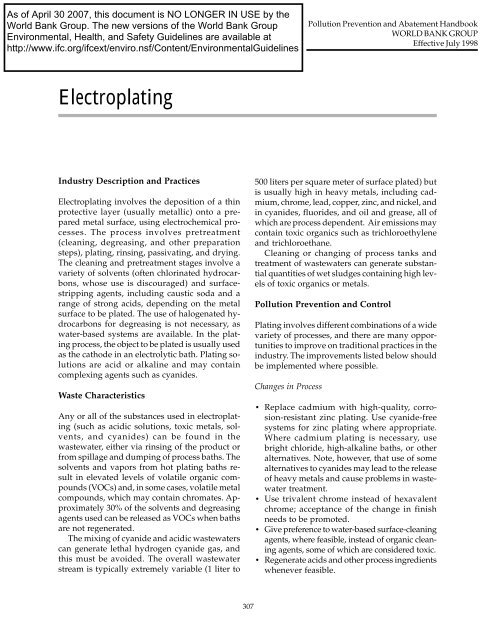
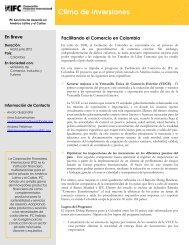
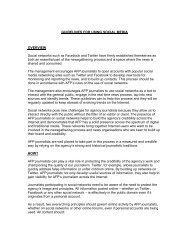
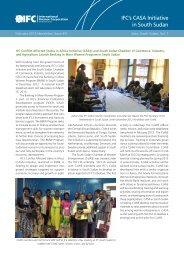

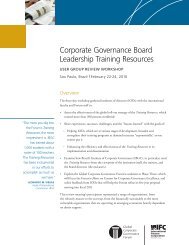


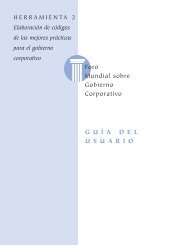


![Print a two-page fact sheet on this project [PDF] - IFC](https://img.yumpu.com/43449799/1/190x245/print-a-two-page-fact-sheet-on-this-project-pdf-ifc.jpg?quality=85)


